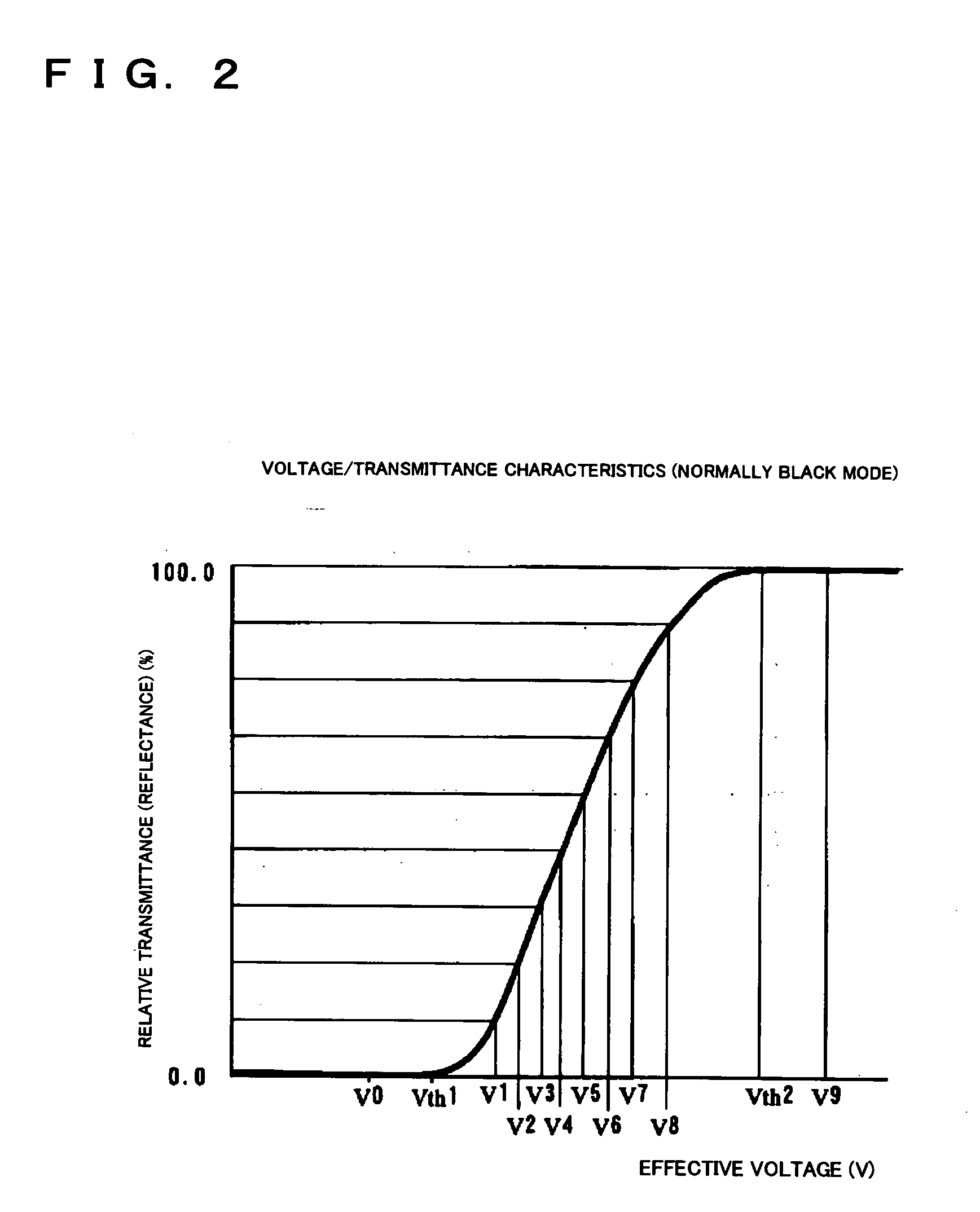Driving method for electro-optical device, electro-optical device, and electronic apparatus
a technology of electrooptical devices and driving methods, applied in static indicating devices, instruments, electroluminescent light sources, etc., can solve the problem of inability to achieve high-quality displays
- Summary
- Abstract
- Description
- Claims
- Application Information
AI Technical Summary
Benefits of technology
Problems solved by technology
Method used
Image
Examples
first exemplary embodiment
[0034] First Exemplary Embodiment
[0035] Before specifically explaining an electro-optical device according to a first exemplary embodiment, the general outlines of sub-field driving in the first exemplary embodiment will be described. FIG. 1 is an illustration for explaining sub-field driving for a liquid crystal element. In FIG. 1, the relationship between a voltage applied to a pixel and gradation data is shown for each sub-field. In general, in a case where a liquid crystal element is used as an electro-optical element in a pixel, data is supplied to the pixel at a voltage level. Also, AC driving in which the level of the voltage polarity is inverted at predetermined intervals (for example, for every one frame) increases the longevity of liquid crystal.
[0036] Gradation data that defines display gradation of a pixel is, for example, 64-gradation data composed of 6 bits, D0 to D5. One frame (1 f) is composed of three sub-fields, SF1 to SF3. In the relationship with gradation to be ...
second exemplary embodiment
[0064] Second Exemplary Embodiment
[0065] FIG. 10 is an illustration for explaining sub-field driving according to the second exemplary embodiment. In FIG. 10, the relationship between a voltage applied to a pixel and gradation data is shown for each sub-field. The sub-field driving in the second exemplary embodiment realizes 64-gradation display by five sub-fields, SF1 to SF5 using five voltage values V0 to V4. One frame (1 f) is composed of five sub-fields SF1 to SF5. In the relationship with gradation to be displayed, the sub-fields SF1, SF2, SF3, SF4, and SF5 basically have lengths (display periods) provided with weights of 1:1:2:4:8, respectively. However, weighting for the sub-fields SF1 to SF5 may be appropriately adjusted in accordance with the characteristics of liquid crystal. As shown in a voltage setting table in FIG. 11, a combination of voltages for the series of sub-fields SF1 to SF5 is selected from among the five voltage values V0 to V4 in accordance with 6-bit grada...
third exemplary embodiment
[0067] Third Exemplary Embodiment
[0068] FIG. 12 is an illustration for explaining sub-field driving according to the third exemplary embodiment. In FIG. 12, the relationship between a voltage applied to a pixel and gradation data is shown for each sub-field. The sub-field driving in the third exemplary embodiment realizes 64-gradation display by seven sub-fields SF1 to SF7 using five voltage values V0 to V4. One frame (1 f) is composed of seven sub-fields, SF1 to SF7. In the relationship with gradation to be displayed, the sub-fields SF1, SF2, SF3, SF4, SF5, SF6, and SF7 basically have lengths (display periods) provided with weights of 1:1:1:1:4:4:4, respectively. However, weighting for the sub-fields SF1 to SF7 may be appropriately adjusted in accordance with the characteristics of liquid crystal. As shown in a voltage setting table in FIG. 13, a combination of voltages for the series of sub-fields SF1 to SF7 is selected from among the five voltage values V0 to V4 set as in the sec...
PUM
| Property | Measurement | Unit |
|---|---|---|
| relative transmittance | aaaaa | aaaaa |
| relative transmittance | aaaaa | aaaaa |
| transmittance | aaaaa | aaaaa |
Abstract
Description
Claims
Application Information
 Login to View More
Login to View More - R&D
- Intellectual Property
- Life Sciences
- Materials
- Tech Scout
- Unparalleled Data Quality
- Higher Quality Content
- 60% Fewer Hallucinations
Browse by: Latest US Patents, China's latest patents, Technical Efficacy Thesaurus, Application Domain, Technology Topic, Popular Technical Reports.
© 2025 PatSnap. All rights reserved.Legal|Privacy policy|Modern Slavery Act Transparency Statement|Sitemap|About US| Contact US: help@patsnap.com



